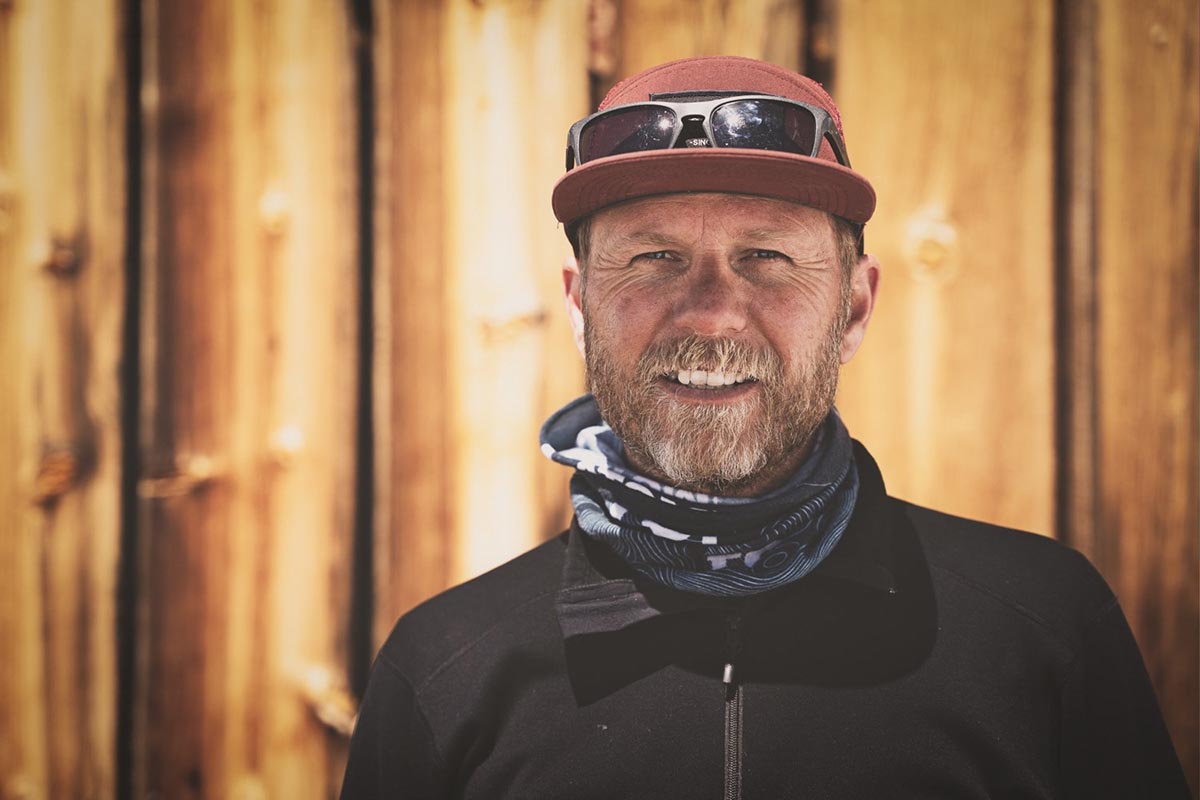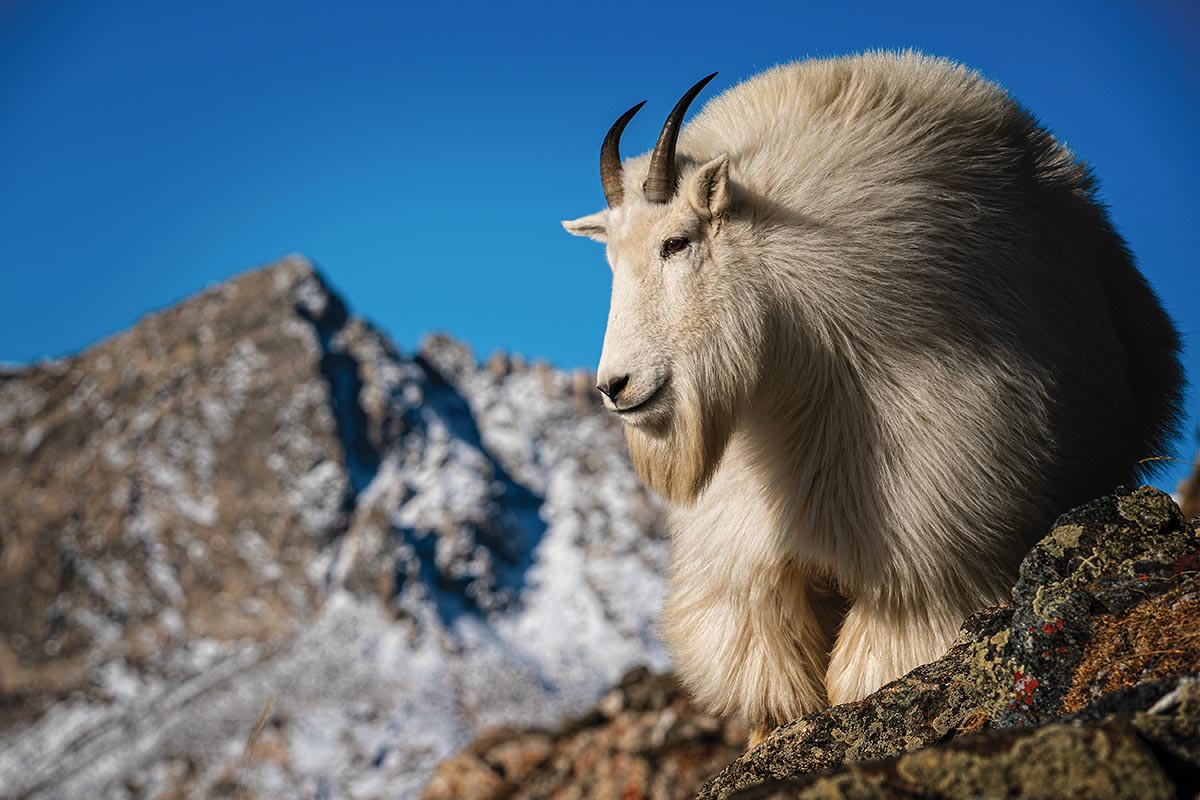Liam Doran’s favorite image of the year? Easy: It was made in Norway during a ski shoot. Another photographer had advised Doran’s group to check out a particularly scenic skiing area and when asked for more detailed directions, she said, “Oh, don’t worry. You’ll find it.” Sure enough, as their vehicle turned a corner on a back road in Digermulen, they knew what she meant. “We were like, Oh my god. It’s right there.” They put on their climbing skins to head up high on the hill, where they found plenty of fresh snow and a gorgeous view of the fjord below. Doran took advantage of Norway’s extended golden hours before sunset, which can last two and a half hours, to photograph the athletes performing in ideal light.
“And then right as the sun is about to drop behind the mountains in the background, my skier comes in and makes a huge left footer and throws up pink snow into the air,” he says. In the background was the Norwegian fjord below and the mountain peaks beyond, providing full context of the jaw-dropping scene.
“That was a really phenomenal night,” he says. “You get to the bottom of the mountain, and everyone is just high-fiving and drinking a beer, and [thinking], Oh my god, that’s as good as it gets.”

AS GOOD AS IT GETS
It’s a joke, but also true, says Doran, that “pure fear of having a desk job and working in a cubicle” is what motivated him to pursue adventure and outdoor sports photography and make it his job. In the early to mid-aughts, when most of his friends were getting married and setting up 401(k)s, Doran was earning $12 an hour working part time at a ski shop in Breckinridge, Colorado, and spending the remainder of his time sharpening his photography skills on the sports he loved, like skiing and mountain biking.
Doran grew up in Denver and spent his childhood participating in outdoor sports, so that part came easily. But the photography didn’t, at least at first, he admits. In those days, there were no YouTube photography tutorials to devour online. “You just had to figure it out,” he explains. Once he had a set of images he liked, he forwarded them along to the editor at Powder magazine, hoping to be published. The editor’s response was less than enthusiastic. “Dear Mr. Doran,” it read. “Please take a look at our magazine and notice the quality of the images. Notice the images are sharp, notice they are well exposed, notice the compositions are dynamic.” It went on and on in that vein, says Doran. “Basically, no thanks. Your work is terrible.”
The letter almost convinced him to quit. But he continued working at it for the same reason he always has: He loves it. “I was just like, I don’t care. I’m just going to keep on shooting and see what happens.”

THE HUSTLE
What happened was a successful commercial and editorial photography business in the adventure and outdoor sports photography niche. Today, Doran’s commercial clients include big names like Patagonia, Under Armour, Osprey, and La Sportiva, as well as tourism boards including Travel Alberta, and major outdoor sports magazines such as Outside, Ski, National Geographic Adventure, and, yes, even Powder.
The business of adventure and outdoor sports photography is all about hustle, he says, even for a seasoned professional like him. “If you are not actively emailing, phone calling, and staying in touch with clients, the phone will eventually stop ringing. You have to always be like, Hey, Atomic, what do you have going on? I’m going to Switzerland. [What athletes] do you have there? Maybe we could link up and put together a project.” It’s a full-time freelance career that “is just the constant work of trying to get work,” he says.


There’s no one way work happens, either. He was recently contacted by Rab and Icelantic, two outdoor brands, for a specific assignment to photograph their gear in action in Jackson Hole, Wyoming. But sometimes he’s hired by a tourism board or destination marketing organization to photograph a particular outdoor sports locale. He might bring in professional athletes for the shoot and hit up their sponsors for an additional source of income. “I might say, ‘Hey, Spyder, I have one of your top athletes, we are going to Portillo, she’s in next year’s gear, let’s put a package together.’” It’s a huge advantage to be able to multiply the revenue from one client into multiple streams of income.
There was a time when Doran spent most of each winter traveling for commercial and editorial projects. But with two daughters at home in Breckenridge, he’s reduced that time to five weeks and does most of his summer adventure and outdoor sports photography in the local area. “Wildlife, landscape, fishing, hiking, trail running—it’s all in my zone,” he says.
ADVENTURE PHOTOGRAPHY WISDOM
At 51, Doran is about halfway through his career, he figures. He offers tips for photographers looking to break into the adventure and outdoors sports photography niche.

Photographer Liam Doran
BE AN ACTIVE PARTICIPANT IN THE SPORT YOU’RE PHOTOGRAPHING. To photograph backcountry skiing, you need to be able to backcountry ski at a level where you can keep up with the professional athletes you’re photographing. Same goes for rock climbing, surfing, trail running, and other sports.
LIVE WHERE THE SPORT IS HAPPENING. You can’t build your skills in rock climbing photography if you live in area that is nothing but cornfields. You need to live in a place like Boulder, Colorado, where the landscape is right, and you have ready access to the sport.
BE THERE. To get the best images, you need to work the edges of the day—sunrise and sunset—when the shadows are long and the light casts a warm tint. That means arriving early and staying late.
PHOTOGRAPH WITH INTENT. Before you make a shot, ask yourself why you’re holding up the camera. What are you making a picture of? “It can’t just be, Oh, it’s pretty. That is not enough. You need an angle, an intent, a thought,” says Doran.
THINK IMPACT. Capture one or more of these elements: intense action, incredible backdrops, unreal light, and storytelling. “Ideally, if you can get all four of those into one photo, you have killed it.”

PHOTOGRAPH THE DETAILS. Yes, you want to give your client photos of the athletes in action, but what else is going on? For example, if you are photographing fly fishing, include detailed photos of the intricate flies.
TELL THE WHOLE STORY. “Years ago, I brought my portfolio into an editor, and he said, ‘This I great, I get it, you can shoot action. But I need to see the rest of the story. What does the place look like? How was the food?’” Doran explains.

STORE IMAGES PROPERLY. After a shoot, Doran drops images onto his computer as well as an external hard drive, and also keeps the card itself. That way he has three copies. When traveling, he keeps one copy of the images in his luggage and two on his person.
CLEAN YOUR EQUIPMENT. “I just beat the hell out of my gear,” Doran says, “and it’s amazing how well it holds up. But I use it, I don’t abuse it.” When he returns from shooting, he pulls all his gear out of his backpack, dries it off, cleans off the ice, snow, and mud, and removes the lens caps to let the moisture dry out.
TAKE CARE OF YOURSELF. Doran often photographs professional athletes in their 20s and 30s who are in peak physical shape, so it’s important that he stays in good physical condition as well. He keeps himself hydrated and well fed and takes care of his body after returning from a trip.
BE A WEATHER FORECASTER. Each outdoor sport carries its weather risks: For example, rock climbers need to be wary of rain. Since Doran often photographs winter sports, he closely watches avalanche conditions. If he hasn’t been backcountry skiing in a couple of weeks, he reaches out to friends who’ve skied the area recently to check up on the conditions before he gets out there himself. He also keeps close watch on forecasts from the Colorado Avalanche Information Center.
LEARN HOW TO WRITE. Doran’s writing skills have helped him get a leg up in the editorial niche, as he sometimes writes first-person articles. He’s also written for brands, including Sigma, for whom he’s an ambassador and contributes blog posts. Good writing skills are also important for composing clear, concise pitches to brands and magazines when he’s in search of financial support for a project.
KNOW IT’S A PASSION-DRIVEN NICHE. “It’s not like a wedding photography business where you put out a sign and say, I’m a wedding photographer, and then the business comes to you.” You have to drum up your own work all the time.
LOVE OF THE LIFE
Doran has come a long way since that ominous feedback from the Powder magazine editor. In fact, 10 years after he received that letter, the same editor invited him out on stage in front of 3,000 people in the outdoor sports community and handed him Powder’s Photo of the Year award. “It took a full decade, but I went from absolute worst photographer to, at least for that night, the best,” he laughs.
Making that journey from worst to first took a lot of toil. But ultimately it boils down to love—love of outdoor sports, love of photography, and love of the lifestyle. “If all my clients fired me, if all my sponsors dropped me, you know what I would still be doing?” poses Doran. “I would not change a thing. I would still be doing the exact same thing I do. That is how much I love adventure photography.”
Amanda Arnold is a senior editor.


 View Gallery
View Gallery


